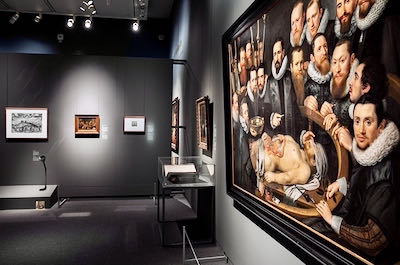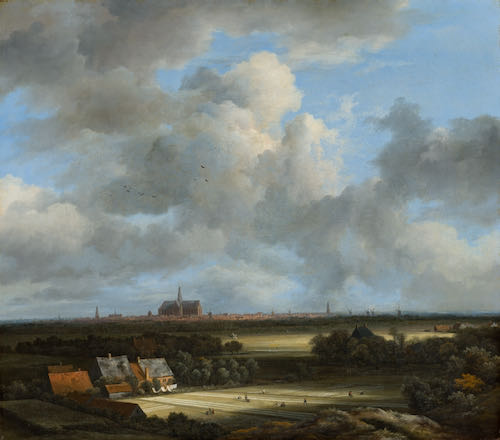
How to smell an art exhibition
ArtWizard 26.04.2021
“In some 17th-century artworks the suggestion of smell is so strong that you can almost imagine yourself in the moment. Do you experience a painting differently if you can also literally smell the work as you look at it?”
Mauritshuis museum, The Hague
Recent technologies nowadays allow viewers to see painting exhibitions in museum virtual tours. Viewers can walk virtually in the different museum halls and admire the exhibitions from their home. The visual perception of art changes from physical to virtual, but until now it still stays within the limits of the visual perception.
However, the way art is admired and perceived changes every day and for the first time, a new dimension to the perception of art is added by the Dutch museum Mauritshuis in The Hague. Until now, paintings have been perceived through our eyes with colors and form having the strongest influence on the human soul, as noted by Wassily Kandinsky in his major book about colors the role of colors and forms in art “Concerning the spiritual in art” /Über das Geistige in der Kunst/.
Today, to the visual sense is added for the first time also the smell. The Mauritshuis museum in the Hague opens an exhibition that adds the smell to the sense of the viewers, with scent dispensers emitting odours fragrant associated with the paintings.
The exhibition is named: “Smell the Art: Fleeting – Scents in Colour”. It is designed to evoke the smells associated with the daily life of the 17th century Europe, thus pairing the eye’s perception of the paintings from that time with the experience of the nose.
The scents are designed to be activated by the viewers by the push of a pedal placed in front of the painting, that releases a scented air associated with the specific painting. One of the common smells that can be experienced in this exhibition is the one of a polluted canal, for example, evoking the way the Dutch canals smelled in the 17th century. Dutch canals can be found depicted in many paintings, such as for example the View of Oudezijds Voorburgwal with the Oude Kerk in Amsterdam, painted around 1670, for which such scent experience is provided in the exhibition.
The painter Jan van der Heyden was known as an inventor – he invented the fire engine and the street light, although he was an accomplished fine art painter that depicted the city of Amsterdam and other Dutch region’s landscapes. In the View of Oudezijds Voorburgwal with the Oude Kerk in Amsterdam, van der Heyden made a perfect image of the oldest part of the city of Amsterdam: the Old Church (Oude Kerk) and the canal around it. As the viewer of this painting admires the detailed and very fine Dutch golden century paintings landscape, what would be the surprise in the perception of the landscape if the viewer could also feel the smell of this same landscape. The visual and scented perception of the painting transfers the viewer into old times, much like a time mahine, and that is precisely what the Mauritshuis museum aimed to show.
.jpeg)
Jan van der Heyden, View of Oudezijds Voorburgwal with the Oude Kerk in Amsterdam, c.1670
The painting displays a very peaceful landscape in a quiet atmosphere with boats and swans and the viewer is picturing a somewhat idyllic life scene when looking at such painting. However, the new scent feature might change this perception,adding the smell of a polluted canal or the sweet rotten smell of the so-called “bad air” of the time, that was known for causing illnesses, as was the idea behind the exhibition shared by some of the curators of the museum.
Much like the colors and forms can influence the human soul and send specific vibrations to the viewers of a painting, as established by Kandinsky, the smell is also a very important sense that has not until present being part of the visual arts perception. And thus, it was not used to add any additional dimension to the art viewers. However, the influence of scents,good or bad, such as perfumes and room fresheners or the odor of a polluted canal, on the psychophysiological activities of humans has been known for a long time.
A fragrance consists of volatile chemicals that humans perceive through the olfactory system. In humans, about 300 active olfactory receptor genes are devoted to detecting thousands of different scent molecules through a large family of olfactory receptors of a diverse protein sequence. The smell is also often considered the most evocative sense. Thus, the sense of smell plays an important role in the physiological and psychological effects of mood and the way of perception. The crucial role of different scents in human psychology has been told as a very memorable fiction story by the German writer Patrick Süskind in his novel “Perfume: The Story of a Murderer”/ « Das Parfum. Die Geschichte eines Mörders ».And so the Mauritshuis museum exhibition adds a whole new dimension as to how the human soul can be influenced by art.
The viewers of the exhibition can discover several smells, such as the smell of the Dutch bleaching fields in the View of Haarlem with Bleaching Grounds by Jacob van Ruisdael, or the smell of a linen cupboard that can be scented viewing the Willem van Mieris, A Grocer's Shop, 1717, along with the canal smells of the View of Oudezijds Voorburgwal with the Oude Kerk in Amsterdam.

Jacob van Ruisdael, View of Haarlem with Bleaching Grounds, c. 1670 - 1675
.jpeg)
Willem van Mieris, A Grocer's Shop, 1717
The Mauritshuis exhibition is announced to be accessible for a view as soon as the museum opens doors again, until and including 29 August 2021. The museum offers one of the best virtual tours and adds to the experience the fragrance box, containing four different scent pumps to go with paintings in the exhibition.
.jpeg)
Fragrance Boxes, Mauritshuis, The Hague
The fragrance box can already be bought online so that the scents can be used in a virtual tour at home in order to have the full visual and scent experience of the somehow revolutionary exhibition: “Smell the Art: Fleeting – Scents in Colour” even before it’s physical opening.
*Courtesy for the images to the Mauritshuis museum, The Hague
